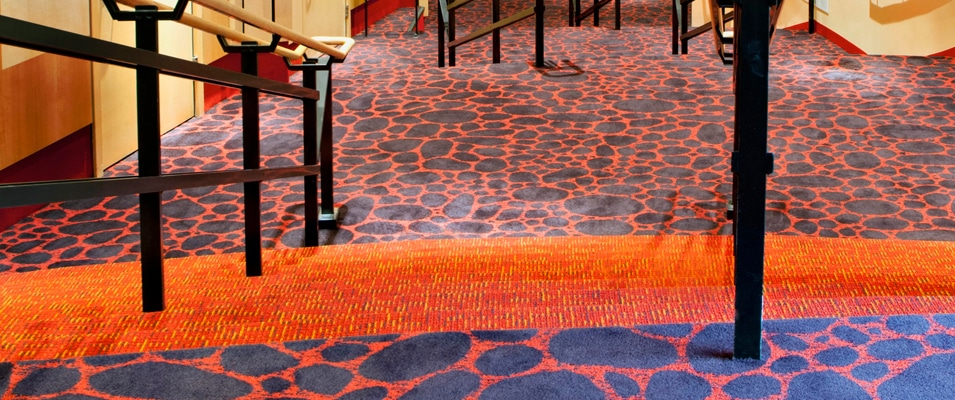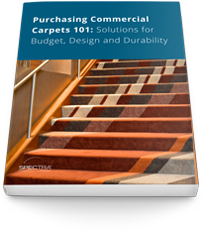Commercial carpet installation costs — and how you can minimize them
The majority of commercial carpet installation costs fall under three broad categories:
- The cost of materials
- Professional costs of working with a specialty flooring contractor, including labor and guidance selecting flooring solutions
- Long-term maintenance costs
Getting the best value for your floor means minimizing total costs while getting a carpet that looks good and functions properly for as long as possible.

Commercial carpet materials costs
Carpet materials often account for the largest portion of carpet installation costs. In addition to fitting your budget, the carpet materials you select must match your interior design and stand up to the hazards of your facility.
Face material is the part of the carpet that you see and is made of yarn fibers. It accounts for about 80 percent of carpet material costs. Any type of face material can come branded or non-branded, with branded materials costing more but often delivering higher quality.
The two most common face materials are nylon, which accounts for about 65 percent of carpets sold in the U.S., and polypropylene (olefin), which is used in about 30 percent of carpets.
Nylon face material is a highly durable solution but also the most expensive option. It comes in two types, 6, the standard option, and 6,6, the premium and most durable material.
Olefin face material is quickly growing in popularity. It’s relatively inexpensive and offers great stain resistance, with the exception of oil-based stains. It retains its color well against spills and sunlight but tends to have poor abrasion resistance and isn’t a great option for high traffic areas.
The right choice depends on the hazards of your facility environment.
Four other types of face materials account for nearly all other carpets in use today, with some used in specialty and premium applications:
- Polyester
- Wool
- Acrylic
- Cotton
Commercial carpet installation costs
The second cost category we’ll address is the professional cost you pay for installation and guidance through the material selection process. Commercial carpet installation costs vary from contractor to contractor, but you can generally reduce installation costs in two ways.
First, select the right type of carpet for your facility, as it affects not only the cost of material, but also the cost of installation. By selecting a carpet that’s easier to install, such as carpet tile, you may be able to reduce installation time. A faster installation reduces direct labor costs and the opportunity cost of not having your facility fully operational during installation.
Second, select a contractor with a skilled, experienced team that has expertise in a variety of carpets. Your contractor’s level of training and processes impact the value you realize from your carpet. To learn more about contractor selection, read our article on the key traits of a sound commercial flooring contractor.
Long-term carpet maintenance costs
To achieve the greatest value for your carpet investment, you’ll want a carpet that will last and deliver value over the long term. If you select the wrong carpet for your environment, your maintenance costs can far outweigh the initial costs of installation and materials. Through the life cycle of your floor, the durability of your carpet also affects its functional use and appearance. To realize the best value, you can take three simple steps.
First, have a specialty flooring contractor test your floor underlay for moisture and alkalinity problems that could damage your new carpet. If you fail to test your underlay and get proper surface preparation, you may end up paying a high replacement cost.
Second, gain a thorough understanding of the hazards and unique requirements of your facility. The more hazards your carpet faces, the more susceptible it is to degradation over time, and the more maintenance costs you may incur. Different hazards affect carpets in different ways. Some of the biggest include constant exposure to sunlight, food consumption, moisture (particularly from spills), exposure to chemicals and general wear from high foot traffic. Various carpet materials resist different hazards, so selecting a carpet with the right face material for your environment can reduce degradation and maintenance costs.
Third, have your specialty flooring contractor provide you a Life Cycle Costing report, which provides an analysis of up-front costs and maintenance costs for different materials. Then, you can make an informed purchase, minimizing your risk of future costs and realize the greatest value.
Get the complete picture and find a carpet that suits your needs
In addition to what we’ve covered in this post, other factors affect the cost of your carpet, the design you can achieve and your carpet’s performance. We’ve created a complete buyer’s guide to purchasing carpets that walks you through the key decisions you must make throughout the process. To download your copy today, simply fill out the form below.

Selecting carpet for your budget, interior design and facility environment
Selecting a carpet that matches your design vision, stands up to your facility environment and aligns with your budget is no small task. We’ve created this guide as a resource to help you make an informed carpet purchasing decision.
